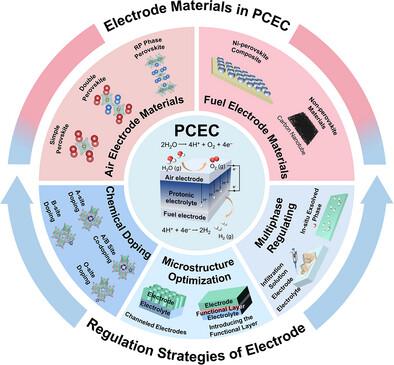当前位置:
X-MOL 学术
›
Adv. Mater.
›
论文详情
Our official English website, www.x-mol.net, welcomes your
feedback! (Note: you will need to create a separate account there.)
Advanced Electrode Materials for Efficient Hydrogen Production in Protonic Ceramic Electrolysis Cells
Advanced Materials ( IF 27.4 ) Pub Date : 2025-06-04 , DOI: 10.1002/adma.202503609
Zhipeng Liu, Lilin Zhang, Chunyue Joey Zheng, Yuan Zhang, Bin Chen, Zongping Shao, Jingjie Ge
Advanced Materials ( IF 27.4 ) Pub Date : 2025-06-04 , DOI: 10.1002/adma.202503609
Zhipeng Liu, Lilin Zhang, Chunyue Joey Zheng, Yuan Zhang, Bin Chen, Zongping Shao, Jingjie Ge

|
Protonic ceramic electrolysis cells (PCECs) exhibit superior proton conductivity under intermediate-temperature operation (300–600 °C), emerging as a promising water electrolysis technology compared to traditional low-temperature proton-conducting polymer electrolysis and high-temperature oxygen ion-conducting oxide electrolysis. However, the sluggish kinetics of the oxygen evolution reaction (OER) and electrode instability in PCECs hinder their large-scale development. This review highlights recent advancements in PCEC technology, emphasizing its thermodynamic and kinetic advantages, the categorization of advanced electrode materials, and material regulation strategies, including chemical doping, microstructural engineering, and multiphase design to improve their catalytic performance and stability. Additionally, the current challenges are discussed and future research directions are outlined for advanced PCEC electrode materials. By summarizing recent advancements in electrode materials and their optimization strategies, this review provides valuable insights into the rational design of efficient and stable electrode materials, advancing PCEC technology for green hydrogen production.
中文翻译:

用于质子陶瓷电解槽高效制氢的先进电极材料
质子陶瓷电解槽 (PCEC) 在中温作 (300–600 °C) 下表现出优异的质子电导率,与传统的低温质子导电聚合物电解和高温氧离子导电氧化物电解相比,是一种很有前途的水电解技术。然而,析氧反应 (OER) 的缓慢动力学和 PCEC 中的电极不稳定性阻碍了它们的大规模发展。本文重点介绍了 PCEC 技术的最新进展,强调了其热力学和动力学优势、先进电极材料的分类以及材料调控策略,包括化学掺杂、微结构工程和多相设计,以提高其催化性能和稳定性。此外,讨论了先进 PCEC 电极材料当前面临的挑战并概述了未来的研究方向。通过总结电极材料的最新进展及其优化策略,本文为合理设计高效稳定的电极材料提供了有价值的见解,推动了 PCEC 技术用于绿色氢气生产。
更新日期:2025-06-04
中文翻译:

用于质子陶瓷电解槽高效制氢的先进电极材料
质子陶瓷电解槽 (PCEC) 在中温作 (300–600 °C) 下表现出优异的质子电导率,与传统的低温质子导电聚合物电解和高温氧离子导电氧化物电解相比,是一种很有前途的水电解技术。然而,析氧反应 (OER) 的缓慢动力学和 PCEC 中的电极不稳定性阻碍了它们的大规模发展。本文重点介绍了 PCEC 技术的最新进展,强调了其热力学和动力学优势、先进电极材料的分类以及材料调控策略,包括化学掺杂、微结构工程和多相设计,以提高其催化性能和稳定性。此外,讨论了先进 PCEC 电极材料当前面临的挑战并概述了未来的研究方向。通过总结电极材料的最新进展及其优化策略,本文为合理设计高效稳定的电极材料提供了有价值的见解,推动了 PCEC 技术用于绿色氢气生产。


















































 京公网安备 11010802027423号
京公网安备 11010802027423号